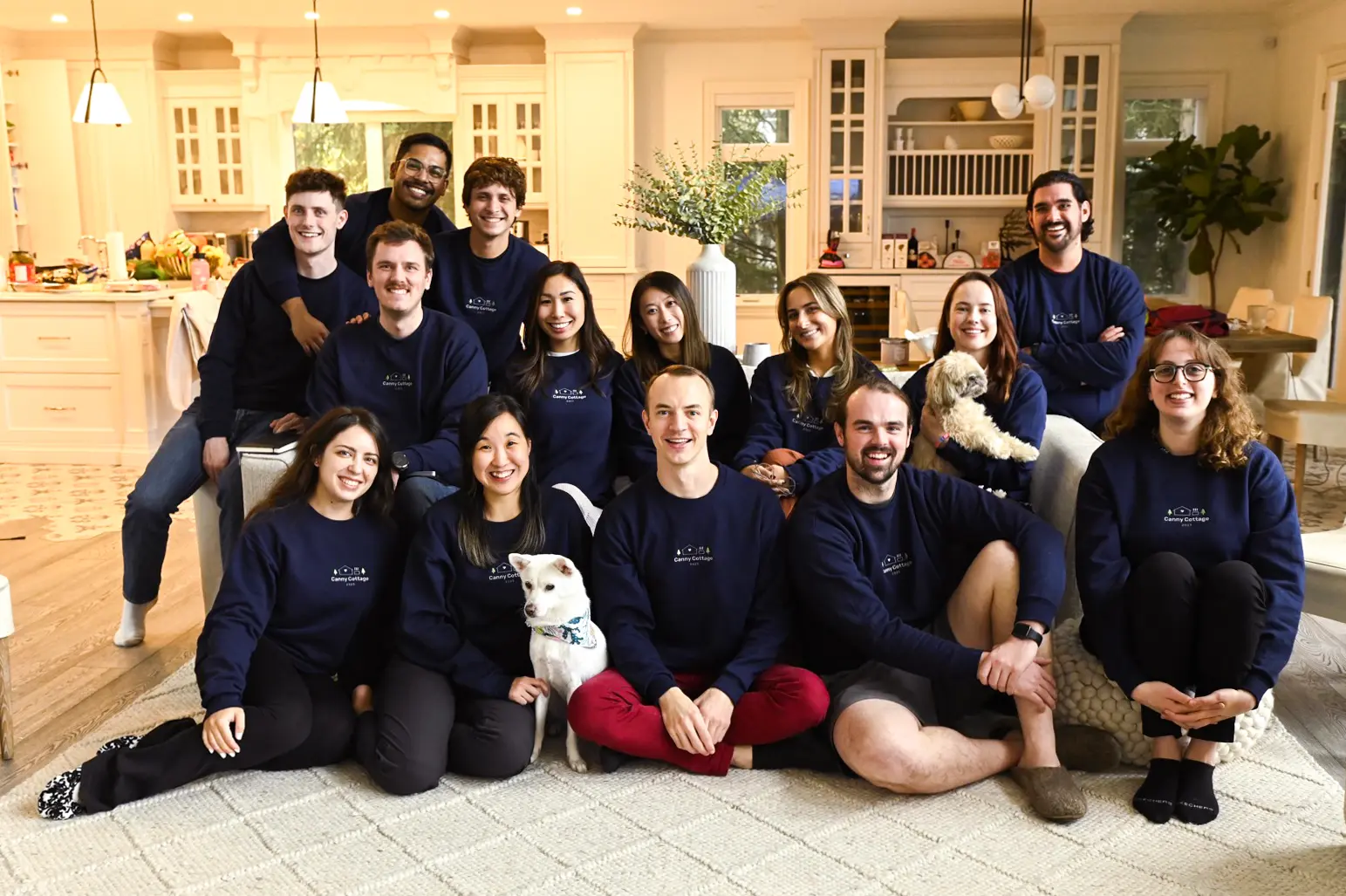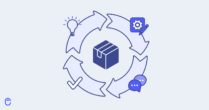Is your team fully remote like ours? If not, did your team switch to being remote or hybrid during the pandemic?
Either way, you know the struggles of keeping the culture alive when working remotely. Even the most introverted team members feel isolated. Don’t get us wrong, we prefer and love remote work. However, we know it comes with its challenges.
How do we overcome them? Team retreats.
When your whole team travels together, very special connections form.
Let’s go behind the scenes of our latest team retreat near Toronto. We’ll tell you all about the planning, execution, and lessons we learned from this experience.
After every retreat, we send out a quick survey to see what the team enjoyed and how we can improve. We’ll share quotes from our team members throughout the article.
Follow along!
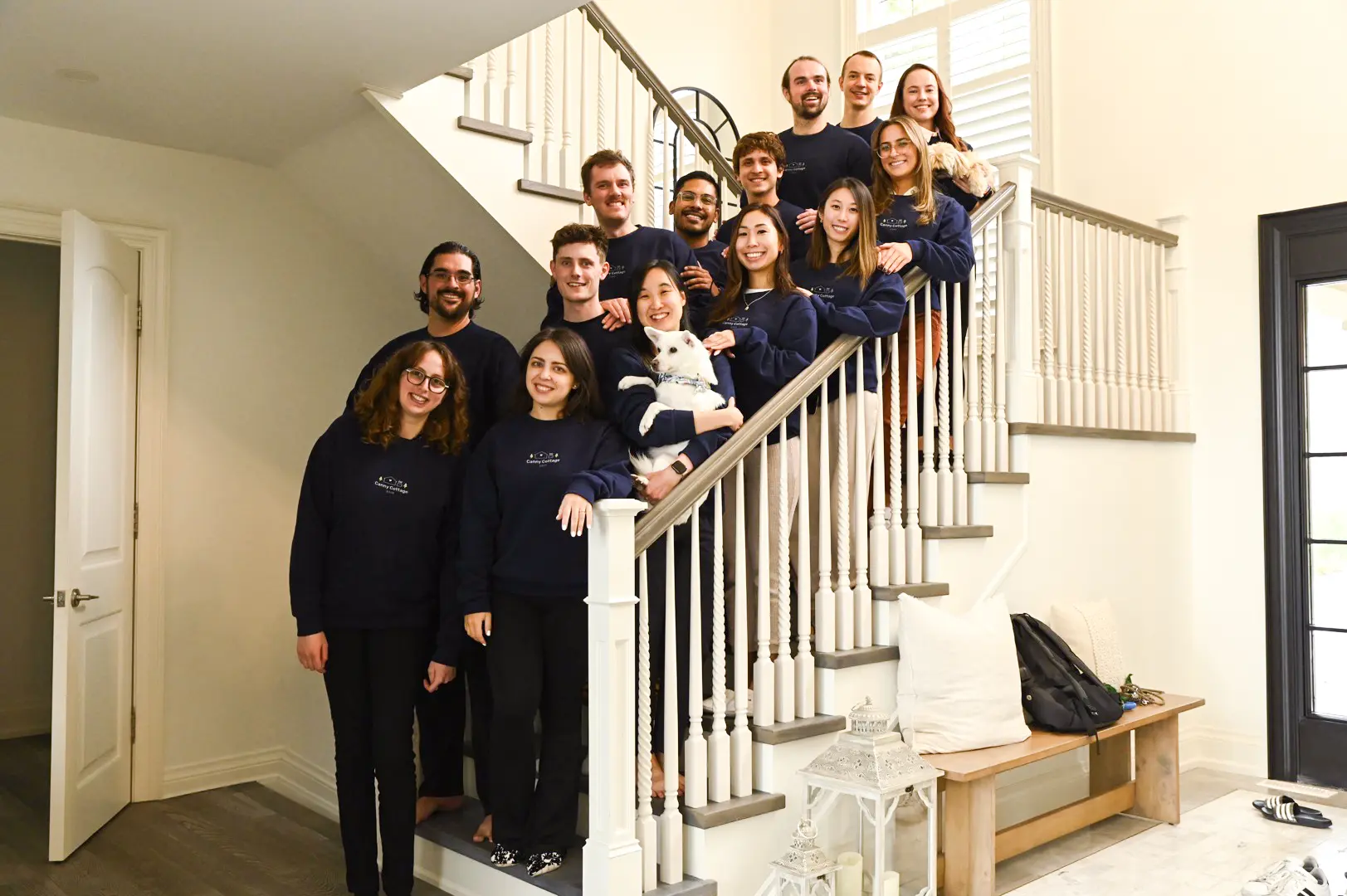
Why retreats?
Especially if you’re a remote-first company, we highly recommend team retreats. They’re a big investment (of time and money), but the benefits far outweigh the costs.
We’ve been doing team retreats since we hired our first person in 2018. From a 3-person to 16-person company, we’ve always prioritized retreats (except for a break during the pandemic).
Everyone always bonds so much during our retreats. People who typically don’t work together start collaborating. Team members who might otherwise stay quiet come out of their shells. Everyone has a chance to share ideas, speak up, and get involved.
Having fun together outside work helps to form special connections between people. Those connections then boost work relationships. We always feel extra energized and motivated after retreats.
“Remote work is like a long-distance relationship. You don’t see your coworkers for 4-6 months and start missing them. When you finally see each other, you have an awesome time together. That’s what makes these retreats so incredible.”
Andrew Rasmussen, co-founder of Canny
This retreat near Toronto was our 8th retreat. We plan each of these retreats ourselves, with no external help. It’s a lot of work, but we enjoy the process and feel very accomplished at the end.
How we pulled it off
As the team grows, planning needs to become more and more detailed and strategic.
Canny started with just two people—me and Andrew. As the team grew, we planned retreats for up to five people, and it was pretty manageable. Finding affordable accommodations was much easier, and everyone could stay in the same place.
Now that we’re a team of 16, a lot more planning is involved.
We’re lucky to have a very passionate and dedicated team that helps organize. For Canny Cottage, six of us volunteered to help with retreat planning.
Note: we created a Slack channel to get this going. Anyone can join, but everyone who does has to contribute. That’s our only rule: no lurkers! 🙂
We typically start planning the next retreat as soon as the last one is over. Here’s how it goes.
Choosing dates
Personal trips and other commitments often get planned 3-4 months in advance. We lock in the retreat dates early so everyone can block their calendars.
First, we send out a survey to see which dates work for everyone. Usually, we do a spring and a fall retreat. Summer and winter tend to be busier for people, and we try to avoid intruding on anyone’s personal lives. We also want to make sure most people can attend—this maximizes the value we get out of the retreat.
We always plan our retreats to include a weekend so we have full days away from work. From there, we keep things flexible.
During our previous retreat in Japan, the weekend was rainy. Instead of trying to enjoy Japan in the rain, we shifted our schedule. We spent Friday outside and worked on Sunday.
We used the same strategy this time. It works really well! It’s also easier to book most things on weekdays.
Tip: Choose dates early—3-4 months in advance. Ask for everyone’s availability using a survey and optimize for the majority.
Picking a location
Once we find the dates that work, we start brainstorming destinations. Here’s what we consider each time:
- Visa requirements
- Flights and layovers (we have team members in the US, Canada, Spain, and Turkey)
- Accommodations
- Activities and meals
- Safety and security
- Costs for all of the above
In the past, we’d been to Portugal, the Czech Republic, Croatia, the USA, Spain, Mexico, and Japan. Right now, more than half of our team lives in Canada, with six in Toronto. That made picking Ontario an easy choice, especially after a Japan retreat.
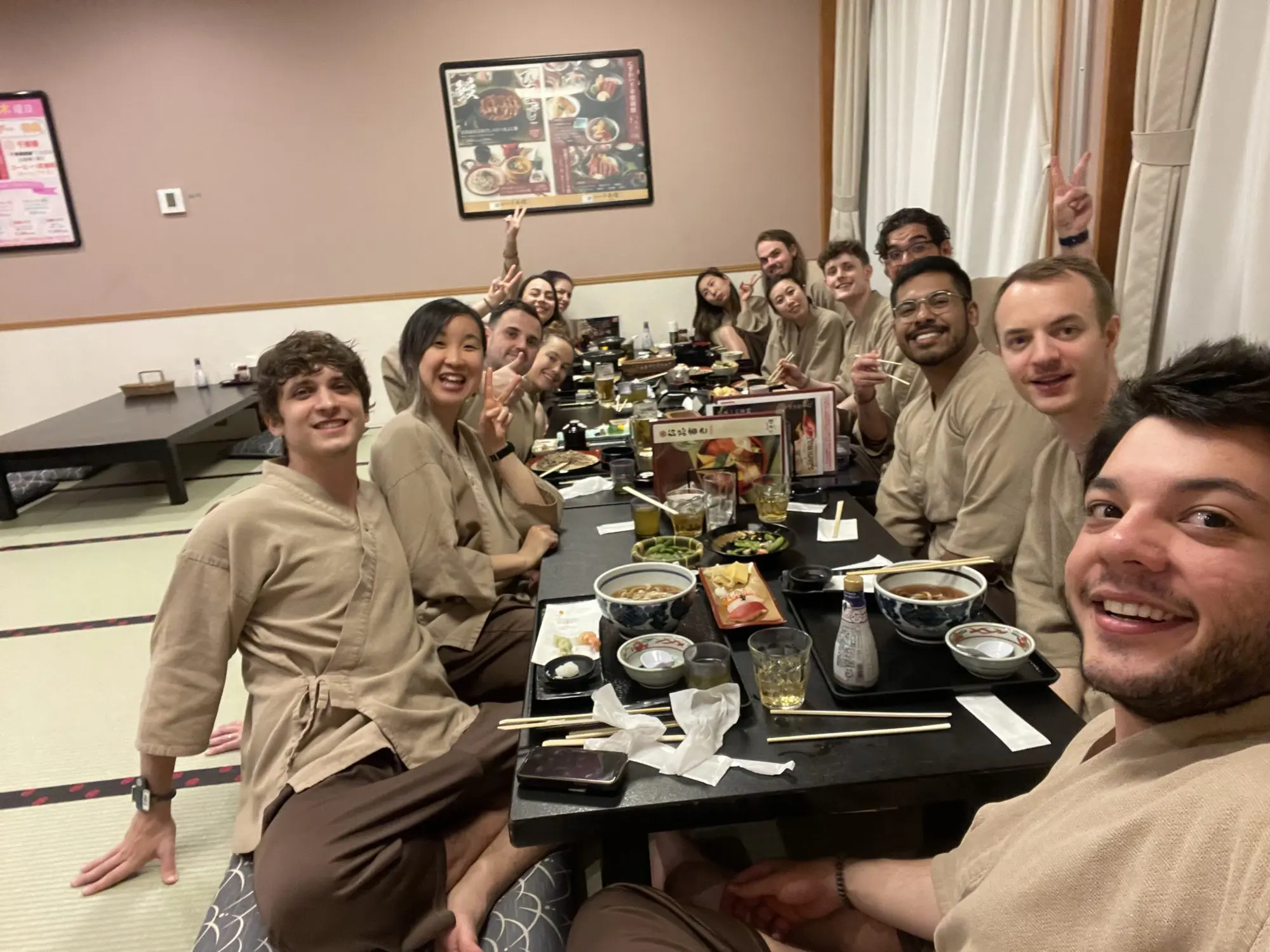
This time, we wanted to focus on accommodations over the destination. We wanted a place where 14 people could comfortably work—both together and independently. Some of us need focused uninterrupted time. Others have to take calls and attend meetings. Our accommodations had to serve both purposes.
We found a luxury lakefront cottage one hour away from Toronto. On top of being a large and beautiful space, it offered lots of cool amenities. We had access to the lake and kayaks, a sauna, multiple hot tubs, and a cold plunge. Indoors, we had a game room, a gym, a movie theater, and lots more.
While the Ontario cottage country isn’t as exotic as Tokyo, we made up for it with an amazing Airbnb.
“The location emphasized to me that the destination isn’t what made it fun. It was the people.”
Adam Laycock, engineer at Canny
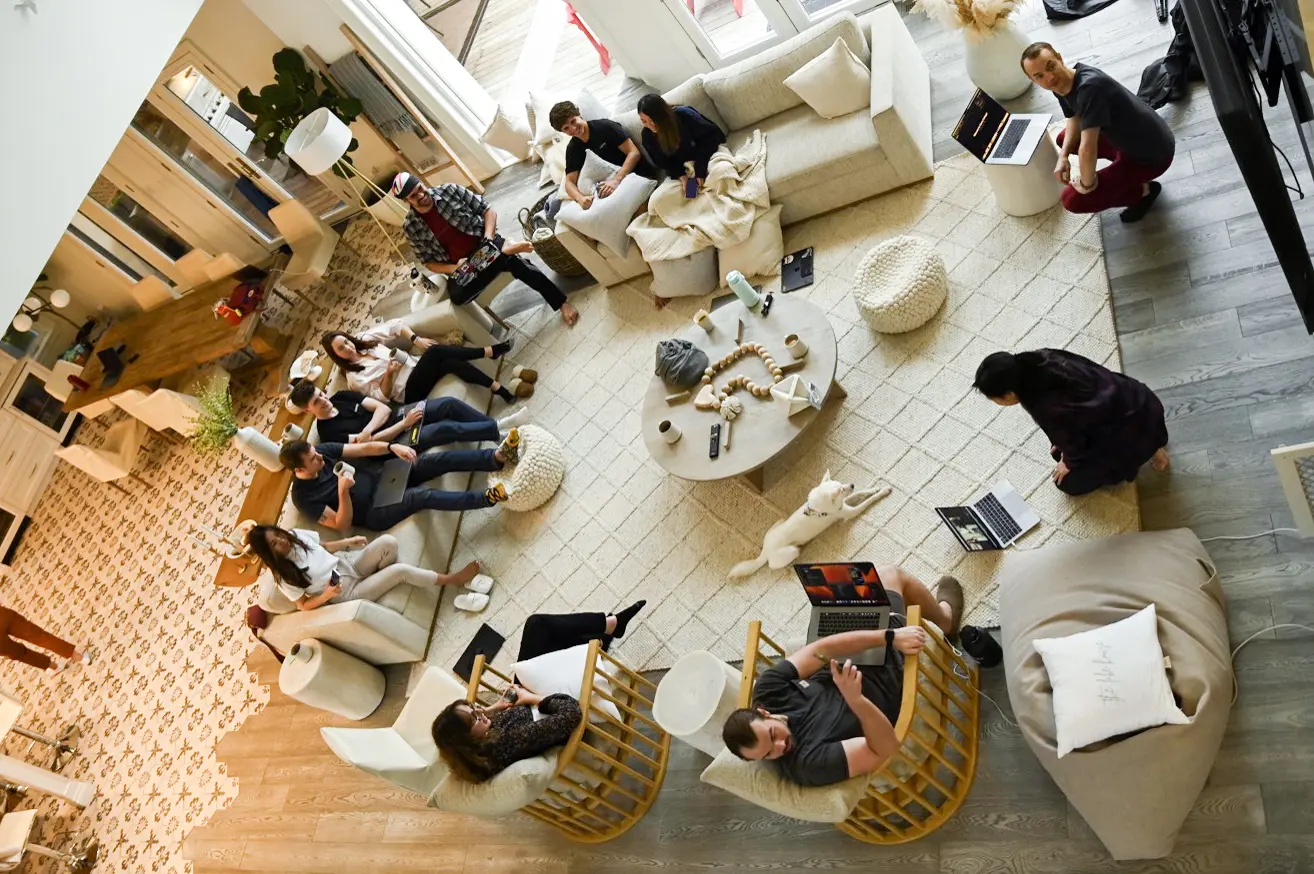
All 14 of us couldn’t comfortably fit into one Airbnb, so we rented another smaller one two doors down. This meant everyone could have their own bedroom—almost all had an en suite!
“Accommodations were super baller. They had all the activities to keep us engaged. It was such a comfy stay.”
Alice Wong, sales at Canny
Everyone had enough space to rest, work, and play.
“I loved the accommodations. Something about staying in such a nice space really makes the event.
Some attributes I loved about our place:
Andrew Rasmussen, co-founder of Canny
- Huge living room and kitchen that can easily fit our whole group
- Great amenities like games room, movie theater, sauna, gym
- Luxurious level of quality”
Tip: If you want to encourage brainstorming and collaboration, make sure your accommodations can serve that. Find a place that offers enough room and a variety of spaces. Large shared spaces, some secluded and quiet areas, and, ideally, “fun” spaces as well.
Arranging transportation
We booked flights for out-of-town guests well in advance to get the best prices.
For transit on land, we rented two Chrysler minivans. We coordinated flights and pick-ups in advance to make logistics go smoothly.
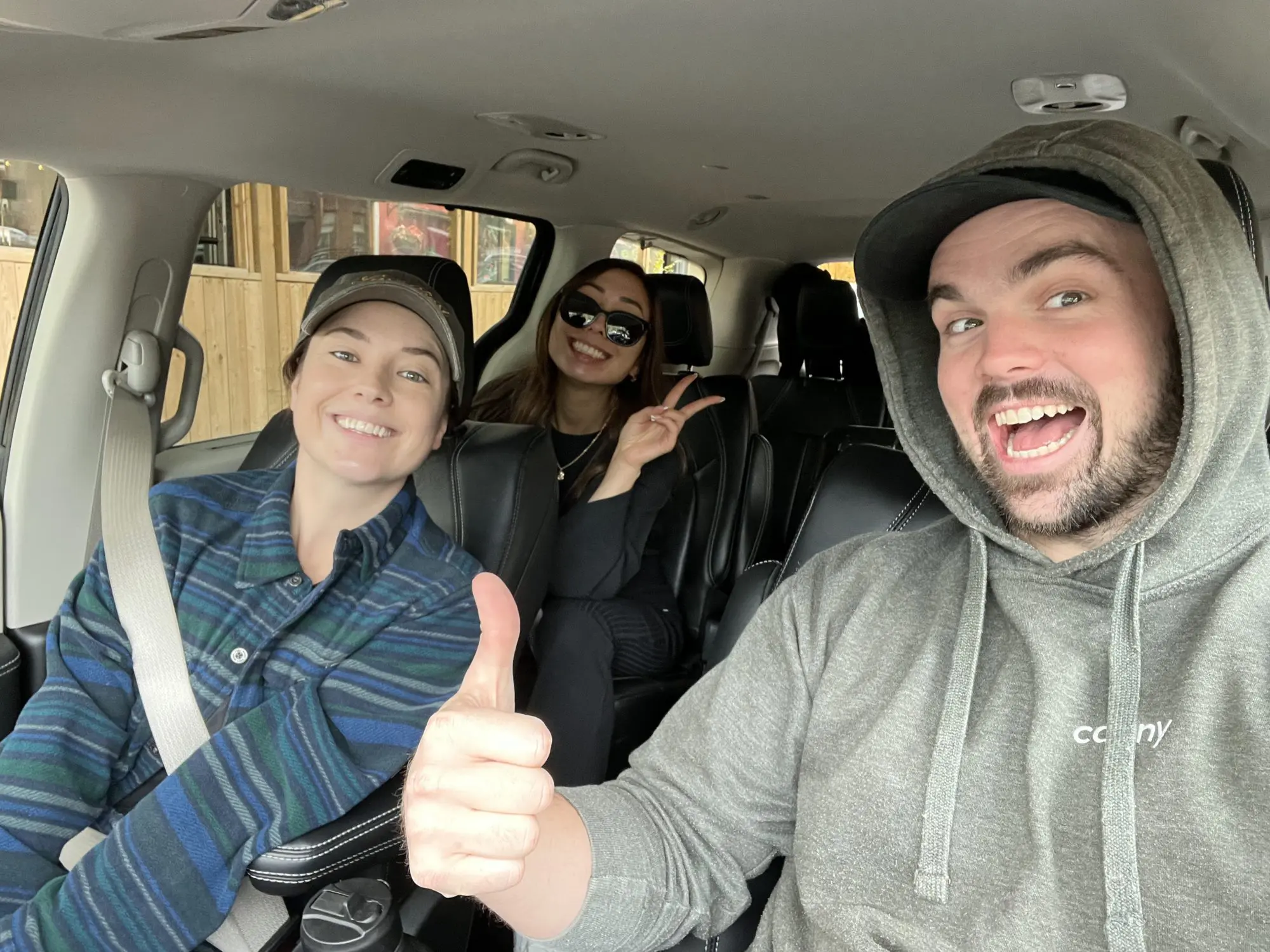
Tips:
- For best cost-savings, think through transportation logistics ahead of time
- Don’t plan any group activities for the first day of the retreat
- Give people time to settle in for the week ahead
Feeding the whole team
This required more planning than usual. Since we didn’t stay in a densely populated city, food options weren’t as readily available.
We started by researching restaurants in the area. Most of the good ones were in a larger town nearby. We wrote down some restaurants and contacted each to see if they needed advance notice for a large order. We also researched delivery options for each. Then, we looked at our activities itinerary and decided which restaurants were on the way to or from those activities.
We briefly considered getting a private chef, but that turned out to be extremely expensive. Catering options were very limited.
When we weren’t going out, we had to make sure we had enough food at home. Since we were staying in a smaller town (35K population), we decided to cook most of the meals ourselves. After all, we had a fully-equipped kitchen in our Airbnb! This worked out well and gave us more opportunities to bond and collaborate.
We planned for all breakfasts and several lunches to be self-serve. We made a food list and a separate food itinerary in Notion. Here’s what it looked like:


Getting organized in advance simplified shopping. We knew exactly what and how much we needed for each meal. In stores, we picked a category (breakfast, lunch, snacks, drinks, etc) and split up. This made shopping more efficient.
A few team members highlighted the home-cooked meals as one of their favorite parts.
Tip: Get super-organized about food. During the retreat, you’ll be too busy to think about it.
Planning activities
Great activities are a big part of making a retreat memorable, so we put a lot of thought into what we want to do.
Before committing to anything, we asked the team what they were interested in. We actually set up a separate Canny board where team members submitted ideas and voted on existing ones 🙂
You can do the same in Canny, and it’s completely free.
We also purposefully made some of them optional. Our past experience showed that some people like to always be on the go, and others prefer more downtime. We wanted everyone to get what they wanted out of this trip.
We researched, planned, and booked the following in advance:
- Local hockey game
- Curling
- Pumpkin patch visit (pumpkin picking, corn maze, hayride)
- Escape room
- Murder mystery game at home
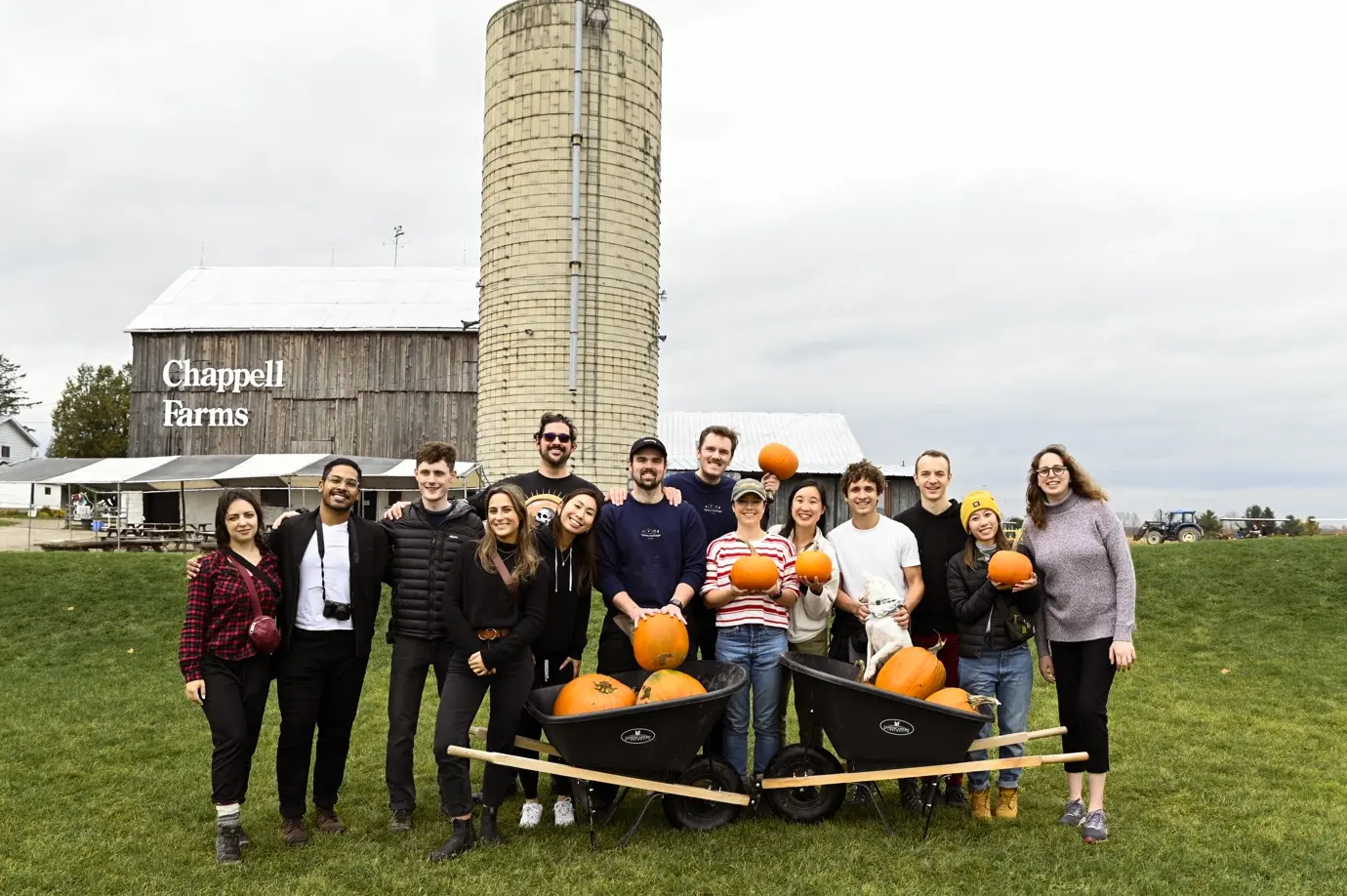
We reserved plenty of downtime to enjoy our Airbnb and everything it had to offer. That included:
- Jam sessions (we rented musical instruments)
- Halloween decorating and party
- Board games
- Movie nights
- Pumpkin carving
- Numerous sauna, hot tub, and cold plunge sessions
Tip: Some things to consider for activities are:
- What’s unique to where we’re staying?
- What festive events might be happening?
- What kind of energy levels can we expect each day?
The itinerary doesn’t need to be jam-packed—allow for sufficient downtime. This leaves room for spontaneity and space to recharge.
“It was nice to have the emphasis on bonding with the team versus exploring the country (like we did in Japan).”
Niall Dickin, engineer at Canny
Getting work done
Retreats are actually some of our most productive work times. It’s a great chance to collaborate in person. We typically do more high-level strategy meetings.
At the beginning of the retreat, we recommend that leadership does a kickoff. It’s a great way to get everyone aligned and in the same mindset for what’s to come during the week. It’s also a good time to share big plans.
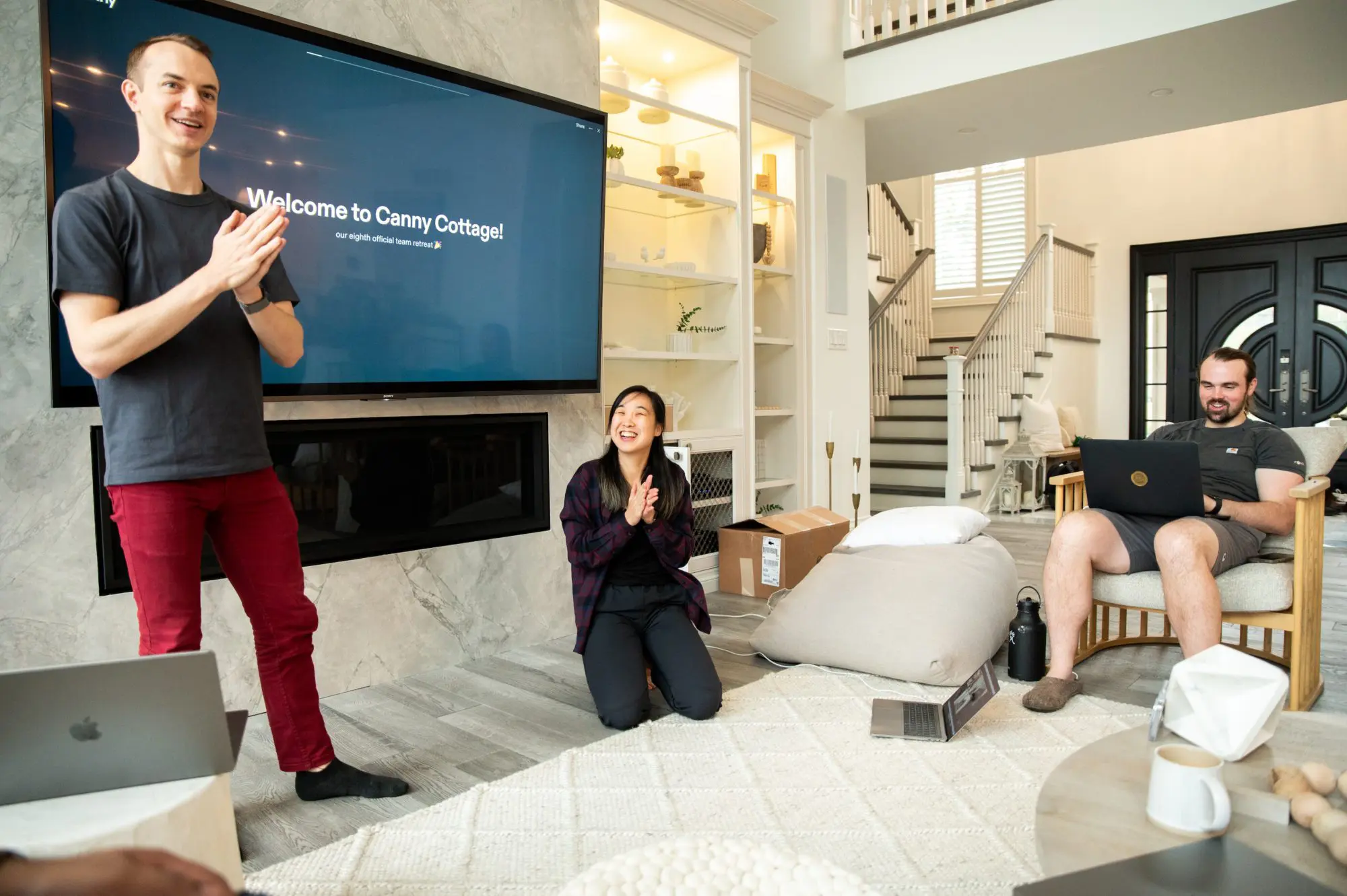
These trips give us a great opportunity to brainstorm together in person. After we go home, we keep that momentum and collaboration going.
To ensure these retreats are productive work-wise, we specify what we want to get done beforehand. This can include:
- Which meetings do we want to hold?
- What specific things do we want to achieve? (complete a project, ship an MVP feature, record a video, etc).
- What ideas do we want to collect? (product features, blog ideas, onboarding initiatives, etc).
Everyone can run a meeting, see how others work, and get involved. We plan meetings in advance and set clear goals and agendas.
“The collaboration was great. It was easy to take action on things quickly.”
Adam Laycock, engineer at Canny
One of our team members, Julia, joined Canny only a week prior to the retreat. This was a great opportunity for her to get to know everyone, shadow others, and bond with the team.
“The collaboration during onboarding was amazing. It provided a great opportunity for us to come together, share insights, and really get to know each other. It was especially helpful in absorbing all the new information.”
Julia Valade, customer success at Canny
On an everyday basis, we sometimes miss a chance to walk up to someone’s desk and pick their brain. This is exactly what retreats like these accomplish.
“Compared to other retreats, this one felt the most productive. I also enjoyed being included in all activities, and I returned home not as tired as from previous retreats.”
Maria Vasserman, content marketing at Canny
The marketing team was able to create lots of content during this retreat. You’ll see some photos and videos pop up on our social media soon. Give us a follow to see them 😉
Tip: Make sure your team’s leadership thinks about how best to use your time together in person. They should be prepared to run meetings by having goals and an agenda. We always have action items noted down at the end of each meeting.
Hackathon
This activity deserves a special mention. After the kickoff, we brainstormed some ideas that aligned with where we want Canny to go. Then, our developers split into pairs, picked an idea, and got to work. They only had a few days to work on their idea, so the goal was to build scrappy but functional MVPs.
Design and marketing teams assisted engineers—they mocked up designs and planned promotions.
On our last day, each team presented their ideas. This day fell on Halloween, so we presented in costumes.
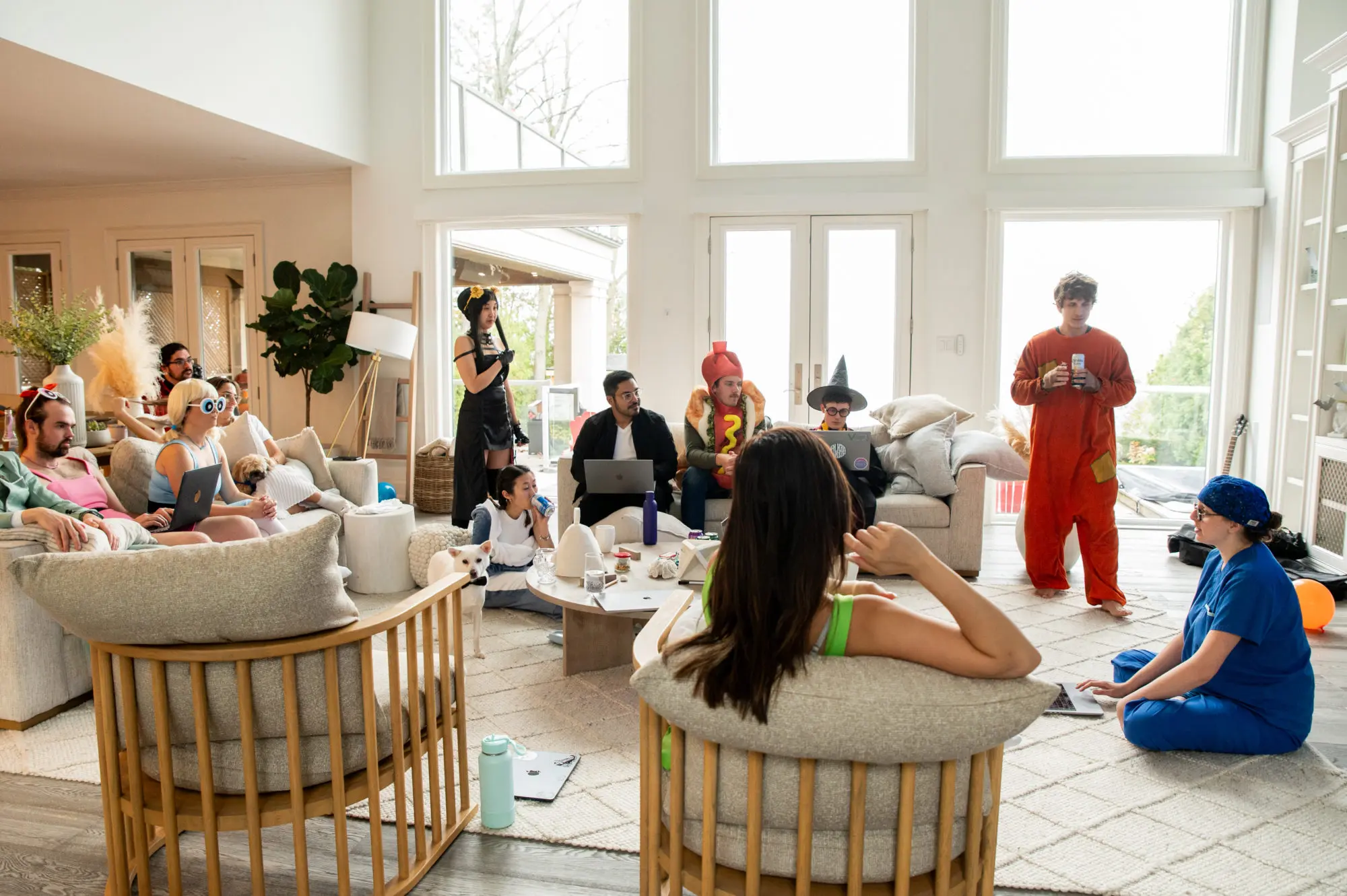
Our Smart Replies feature was born out of this hackathon.
“The highlight was the hackathon. Not just because we built some cool stuff, but also because it let me work 1:1 with a colleague that I haven’t directly worked with before.”
Ramiro Olivera, engineer at Canny
What we learned
Our biggest goal for these retreats has always been bonding. We prioritize culture, and retreats are a huge part of it.
We believe that we achieved that—many people on the team mentioned bonding as one of their highlights.
Spending a whole week with anybody can be overwhelming, not to mention coworkers. We made a point to strike a balance between work, activities, and relaxing. We feel like this retreat in particular accomplished that.
Throughout the retreat, I ask everyone to take videos in landscape mode. At the end of every retreat, I put together a little video. It’s a great way for us to relive every retreat and the good times we had. The video also gives future teammates a glimpse into what working at Canny is like.
We took note of some things to improve for next time:
- Apply for visas even earlier than we think
- Ask for more help with planning when we need it
- Delegate shopping/cooking responsibilities even more
- Make more activities optional
How you can make your corporate retreat awesome
If you’re sold on team retreat now, that’s great. You’ll get a lot out of it, and your team will definitely thank you. Here are a few pointers to help you make it a success:
- Survey the team as much as possible in advance. Ask about dates, locations, preferences, dietary restrictions, activity ideas, etc.
- Plan as early in advance as possible—at least 3-6 months. Think of dates, locations, travel, transportation, visas, schedules, food, activities, and work. We know, it’s a lot.
- Ask for help from the team when you need it. Don’t try to do everything yourself.
- Encourage each team member to set a goal for the retreat. This will help keep this productive and worthwhile.
- Encourage collaboration and participation. Schedule meetings and brainstorms, but also leave time for people to split into groups and do their own thing.
- Remember: it’s impossible to please everyone. Just do your best!
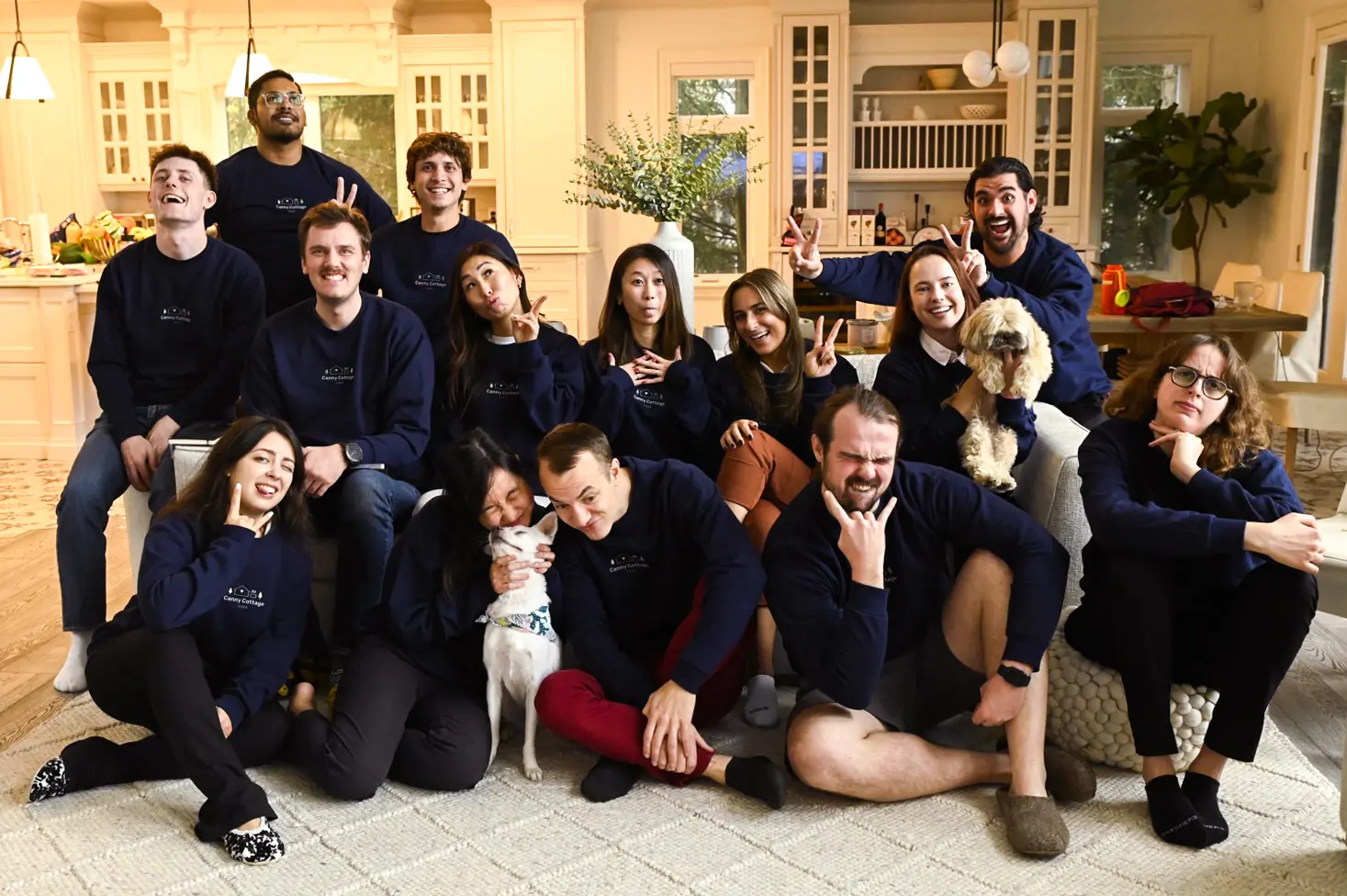
We hope that you’re now excited to plan your team retreat. We’ll share more about our retreats and team activities, so stay in touch.


